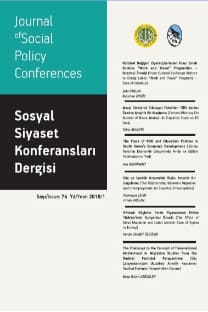EXCHANGE RATE RISK and INTERNATIONAL TRADE: SURVEY RESULTS on TURKISH FIRMS
Döviz kuru riski, Uluslararası ticaret, USD ve Euro
EXCHANGE RATE RISK and INTERNATIONAL TRADE: SURVEY RESULTS on TURKISH FIRMS
Exchange Rate Risk, International trade, SURVEY,
___
- Assery, A. and D. A. Peel (1991), The Effects of Exchange Rate Volatility on Exports: Some New Estimates, Economics Letters, 37, 173-177.
- Bollerslev, T (1986), “Generalized Autoregressive Conditional Heteroskedaticity,” Journal of Econometrics, 31, pp. 307-27.
- Clark, Peter B. (1973), Uncertainty, Exchange Risk, and the Level of International Trade.” Western Economic Journal, 11 (September), 302-13.
- Cushman, D.O. (1986), Has Exchange Risk Depressed International Trade? The Impact of Third Country Exchange Risk, Journal of International Money and Finance, 5, 361-378.
- Engle, R.F. (1982), “Autoregressive Conditional Heteroscedaticity with Estimates of the Variance of United Kingdom Inflation,” Econometrica, 50/4, pp. 987-1006.
- Ethier, W. (1973), International Trade and the Forward exchange Market, American Economic Review, 63, 494-503.
- Franke, G. (1991), Exchange Rate Volatility and International Trading Strategy, Journal of International Money and Finance, 10, 292-307.
- Hooper, P. and S.W. Kohlhagen (1978), The Effect of Exchange Rate Uncertainty on the Prices and Volume of International Trade, Journal of International Economics, 8, 483-511.
- Neumann, M. (1995), Real Effects of Exchange Rate Volatility, Journal of International Money and Finance, Vol. 14, No. 3, 417-426.
- Solakoglu, M. N. (2005), Exchange rate volatility and real exports: A sensitivity analysis, Journal of Economic and Social Research, Vol 7 (1), 1-30.
- ISSN: 1304-0103
- Yayın Aralığı: 2
- Başlangıç: 1948
- Yayıncı: İstanbul Üniversitesi Yayınevi
DEĞERLİ DOSTUMUZ PROF. DR. HAŞMET BAŞAR'I ANARKEN
MARGINALIZED MIGRATION, TRENDS AND POLICIES
TÜRKİYE İŞGÜCÜ PİYASASININ YAPISAL ÖZELLİKLERİ ve İŞSİZLİK SORUNU
ÇALIŞKAN BİR ÖĞRENCİ, DEĞERLİ BİR BİLİM ADAMI VE UNUTULMAZ BİR DOST: PROF. DR. HAŞMET BAŞAR
PROF. DR. HAŞMET BAŞAR'IN ARDINDAN
İŞLETMELERDE PERFORMANS DEĞERLENDİRMENİN ÖNEMİ ve PERFORMANS GÖSTERGELERİ ARASINDAKİ İLİŞKİLER
AVRUPA BİRLİĞİ'NDE UZUN DÖNEMLİ İŞSİZLİĞE KARŞI UYGULANAN İSTİHDAM POLİTİKALARI
"ENTELEKTÜEL SERMAYE"NİN KÜRESEL EKONOMİ İÇERİSİNDEKİ YERİ VE ÖNEMİ
